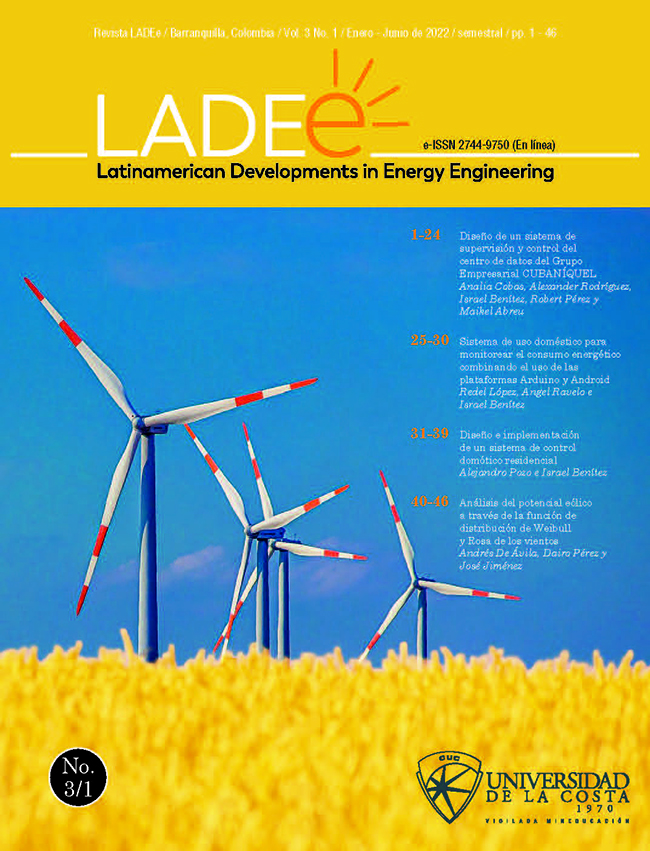Sistema de uso doméstico para monitorear el consumo energético combinando el uso de las plataformas Arduino y Android
DOI:
https://doi.org/10.17981/ladee.03.01.2022.2Keywords:
Domotic, Energy efficiency, Residential electricity consumptionAbstract
Domotic systems rise as an effective strategy to monitor residential electricity consumption towards adequate energy management to reduce household energy consumption. This study developed a low-cost domotic system to measure electricity consumption in real-time in Cuban households. The system is based on Arduino and Android systems, combined with different sensors. Additionally, an app compatible with Android was developed for the interaction between users and the system. During the experimental validation, contrasting the system results to the household electric meter shows that the system measured the electricity consumption with an error of 0.36%. Consequently, the system is suitable to monitor household electricity consumption. Furthermore, this system can be upgraded to implement it in facilities of the tertiary sector.
Downloads
References
[2] A. Sagastume, J. J. J. Cabello, D. Huisingh, C. Vandecasteele, and L. Hens, “The current potential of low-carbon economy and biomass-based electricity in Cuba. The case of sugarcane, energy cane and marabu (Dichrostachys cinerea) as biomass sources,” J. Clean. Prod., vol. 172, pp. 2108–2122, 2018, doi: 10.1016/j.jclepro.2017.11.209.
[3] IEA, “World electricity final consumption by sector, 1974-2019,” Charts – Data & Statistics, Aug. 06, 2021. https://www.iea.org/data-and-statistics/charts/world-electricity-final-consumption-by-sector-1974-2019 (accessed Mar. 03, 2022).
[4] Oficina Nacional de Estadísticas, “Minería y energía,” in Anuario Estadístico de Cuba 2020, La Habana: Oficina Nacional de Estadísticas, 2021.
[5] C. Milanés-Batista, H. Tamayo-Yero, D. de Oliveira, and J. R. Nuñez-Alvarez, "Application of Business Intelligence in studies management of Hazard, Vulnerability and Risk in Cuba, " IOP Conf. Series: Materials Science and Engineering, vol. 844, pp. 012033, 2020, doi: 10.1088/1757-899X/844/1/012033
[6] W. Li, T. Yigitcanlar, I. Erol, and A. Liu, “Motivations, barriers and risks of smart home adoption: From systematic literature review to conceptual framework,” Energy Res. Soc. Sci., vol. 80, pp. 102211, Oct. 2021, doi: 10.1016/J.ERSS.2021.102211.
[7] J. Andramuño et al., "Intelligent distributed module for local control of lighting and electricaloutlets in a home," J. Phys.: Conf. Ser., vol. 1730, pp. 012001, 2021, doi: 10.1088/1742-6596/1730/1/012001
[8] A. M. Vega, F. Santamaria, and E. Rivas, “Modeling for home electric energy management: A review,” Renew. Sustain. Energy Rev., vol. 52, pp. 948–959, Dec. 2015, doi: 10.1016/J.RSER.2015.07.023.
[9] J. R. Nuñez-Alvarez et al., "Communications in Flexible Supervisor for Laboratory Research in Renewable Energy, IOP Conf. Ser.: Mater. Sci. Eng. vol. 844, p. 012016, 2020, doi: 10.1088/1757-899X/844/1/012016
[10] J. Nuñez, I. F. Benítez Pina, A. Rodríguez Martínez, S. Díaz Pérez and D. Luiz de Oliveira, "Tools for the Implementation of a SCADA System in a Desalination Process," in IEEE Latin America Transactions, vol. 17, no. 11, pp. 1858-1864, November 2019, doi: 10.1109/TLA.2019.8986424.
[11] L. Vazquez, J. Luukkanen, H. Kaisti, M. Käkönen, and Y. Majanne, “Decomposition analysis of Cuban energy production and use: Analysis of energy transformation for sustainability,” Renewable and Sustainable Energy Reviews, vol. 49. Elsevier Ltd, pp. 638–645, Sep. 01, 2015, doi: 10.1016/j.rser.2015.04.156.
[12] T. Fletcher, “La revolución energética: A model for reducing Cuba’s dependence on Venezuelan oil,” Int. J. Cuba. Stud., vol. 9, no. 1, p. 91, 2017, doi: 10.13169/intejcubastud.9.1.0091.
[13] G. P. R. Filho, L. A. Villas, V. P. Gonçalves, G. Pessin, A. A. F. Loureiro, and J. Ueyama, “Energy-efficient smart home systems: Infrastructure and decision-making process,” Internet of Things, vol. 5, pp. 153–167, Mar. 2019, doi: 10.1016/J.IOT.2018.12.004.
[14] J. R. Nuñez Alvarez, Y. P. Zamora, I. B. Pina, and E. N. Angarita, "Demilitarized network to secure the data stored in industrial networks," International Journal of Electrical and Computer Engineering (IJECE), vol. 11, no. 1, pp. 611, 2021, https://doi.org/10.11591/ijece.v11i1.pp611-619
[15] K. Baraka, M. Ghobril, S. Malek, R. Kanj, and A. Kayssi, “Low cost arduino/android-based energy-efficient home automation system with smart task scheduling,” Proc. - 5th Int. Conf. Comput. Intell. Commun. Syst. Networks, CICSyN 2013, pp. 296–301, 2013, doi: 10.1109/CICSYN.2013.47.
[16] Ingeniería MCI, “Arduino Mega 2560,” 2022. https://arduino.cl/arduino-mega-2560/ (accessed Mar. 03, 2022)
Published
How to Cite
Issue
Section
License
![]()
You are free to:
- Share — copy and redistribute the material in any medium or format
- The licensor cannot revoke these freedoms as long as you follow the license terms.
Under the following terms:
- Attribution — You must give appropriate credit , provide a link to the license, and indicate if changes were made . You may do so in any reasonable manner, but not in any way that suggests the licensor endorses you or your use.
- NonCommercial — You may not use the material for commercial purposes .
- NoDerivatives — If you remix, transform, or build upon the material, you may not distribute the modified material.
- No additional restrictions — You may not apply legal terms or technological measures that legally restrict others from doing anything the license permits.


 English
English
 Español (España)
Español (España)
 Português (Portugal)
Português (Portugal)




